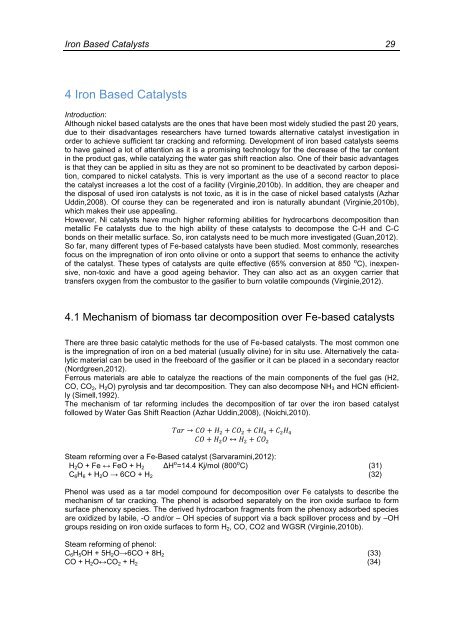Dipl. Ing. Matthias Mayerhofer Technische Universität München ...
Dipl. Ing. Matthias Mayerhofer Technische Universität München ...
Dipl. Ing. Matthias Mayerhofer Technische Universität München ...
You also want an ePaper? Increase the reach of your titles
YUMPU automatically turns print PDFs into web optimized ePapers that Google loves.
Iron Based Catalysts 29<br />
4 Iron Based Catalysts<br />
Introduction:<br />
Although nickel based catalysts are the ones that have been most widely studied the past 20 years,<br />
due to their disadvantages researchers have turned towards alternative catalyst investigation in<br />
order to achieve sufficient tar cracking and reforming. Development of iron based catalysts seems<br />
to have gained a lot of attention as it is a promising technology for the decrease of the tar content<br />
in the product gas, while catalyzing the water gas shift reaction also. One of their basic advantages<br />
is that they can be applied in situ as they are not so prominent to be deactivated by carbon deposition,<br />
compared to nickel catalysts. This is very important as the use of a second reactor to place<br />
the catalyst increases a lot the cost of a facility (Virginie,2010b). In addition, they are cheaper and<br />
the disposal of used iron catalysts is not toxic, as it is in the case of nickel based catalysts (Azhar<br />
Uddin,2008). Of course they can be regenerated and iron is naturally abundant (Virginie,2010b),<br />
which makes their use appealing.<br />
However, Ni catalysts have much higher reforming abilities for hydrocarbons decomposition than<br />
metallic Fe catalysts due to the high ability of these catalysts to decompose the C-H and C-C<br />
bonds on their metallic surface. So, iron catalysts need to be much more investigated (Guan,2012).<br />
So far, many different types of Fe-based catalysts have been studied. Most commonly, researches<br />
focus on the impregnation of iron onto olivine or onto a support that seems to enhance the activity<br />
of the catalyst. These types of catalysts are quite effective (65% conversion at 850 ⁰C), inexpensive,<br />
non-toxic and have a good ageing behavior. They can also act as an oxygen carrier that<br />
transfers oxygen from the combustor to the gasifier to burn volatile compounds (Virginie,2012).<br />
4.1 Mechanism of biomass tar decomposition over Fe-based catalysts<br />
There are three basic catalytic methods for the use of Fe-based catalysts. The most common one<br />
is the impregnation of iron on a bed material (usually olivine) for in situ use. Alternatively the catalytic<br />
material can be used in the freeboard of the gasifier or it can be placed in a secondary reactor<br />
(Nordgreen,2012).<br />
Ferrous materials are able to catalyze the reactions of the main components of the fuel gas (H2,<br />
CO, CO2, H2O) pyrolysis and tar decomposition. They can also decompose NH3 and HCN efficiently<br />
(Simell,1992).<br />
The mechanism of tar reforming includes the decomposition of tar over the iron based catalyst<br />
followed by Water Gas Shift Reaction (Azhar Uddin,2008), (Noichi,2010).<br />
Steam reforming over a Fe-Based catalyst (Sarvaramini,2012):<br />
H2O + Fe ↔ FeO + H2 ΔH⁰=14.4 Kj/mol (800⁰C) (31)<br />
C6H6 + H2O → 6CO + H2 (32)<br />
Phenol was used as a tar model compound for decomposition over Fe catalysts to describe the<br />
mechanism of tar cracking. The phenol is adsorbed separately on the iron oxide surface to form<br />
surface phenoxy species. The derived hydrocarbon fragments from the phenoxy adsorbed species<br />
are oxidized by labile, -O and/or – OH species of support via a back spillover process and by –OH<br />
groups residing on iron oxide surfaces to form H2, CO, CO2 and WGSR (Virginie,2010b).<br />
Steam reforming of phenol:<br />
C6H5OH + 5H2O→6CO + 8H2 (33)<br />
CO + H2O↔CO2 + H2 (34)
















